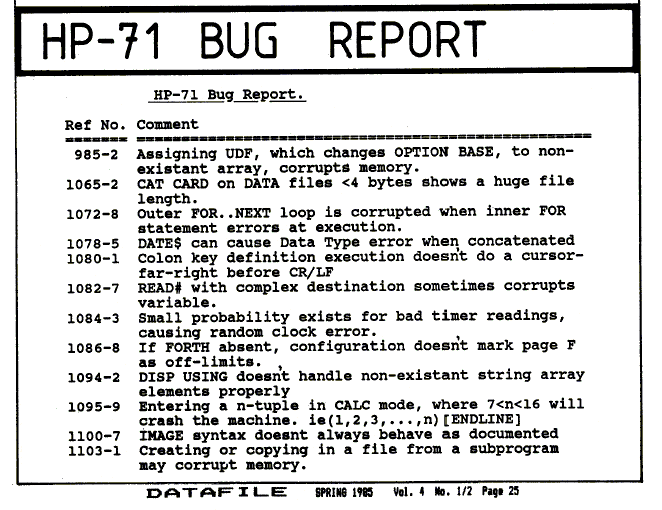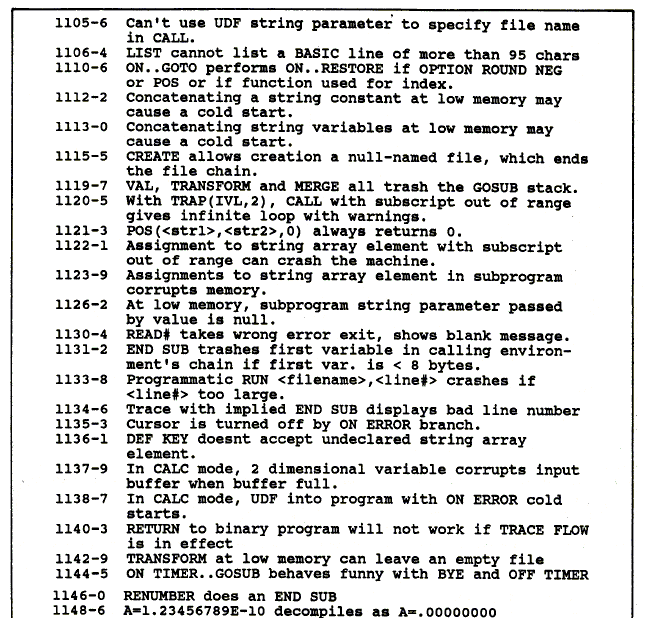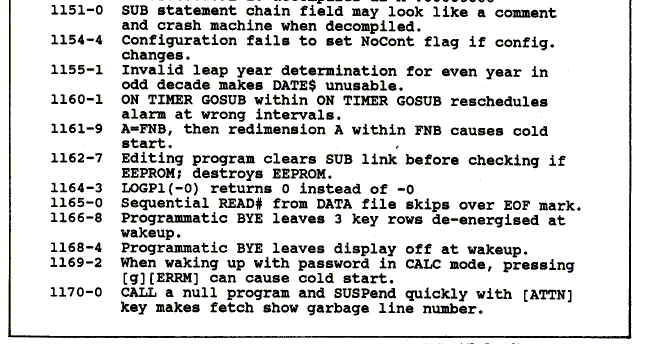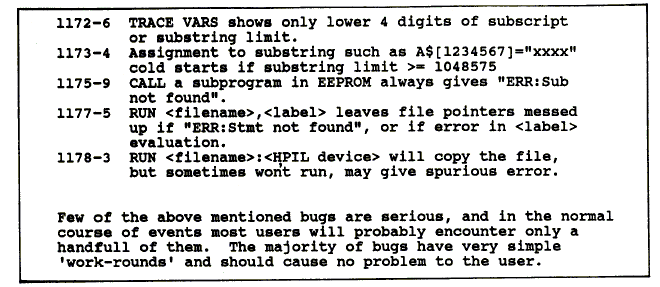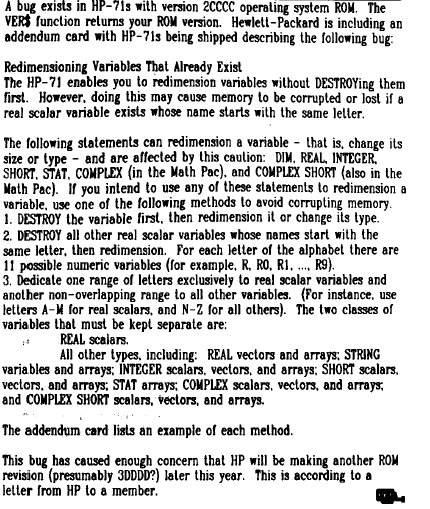HP-71B ROM Versions and Bugs
Return to main page
I present here some information regarding HP-71B mainframe and option ROM versions and bugs:
- HP-71B Mainframe and Option ROM Versions
- ROM 1AAAA bug list, from an analysis of the bug fixes described in the IDS rev. 1BBBB, Dec. 1983
- ROM 1BBBB bug list, as published in Datafile V4N12, 1985
- ROM 2CCCC bug, as published in HPX Exchange V1N2, 1987
- ROM 2CDCC remaining bug, from HP bug report, Feb. 1986
- HP-71B y^x accuracy weakness (new Dec. 2025)
- HP-71B User Manual Addendum 2/84 (french)
- HP-71B Hardware IDS Chapter 8 (System Diagrams)
- HP-IL module ROM version 1A bugs - and more
- HP-IL Internal Design Spec. Update (March 1984)
- Math ROM bugs
- FORTH/Assembler bugs
- JPC ROM versions and bugs
- Contact
HP-71B Mainframe and Option ROM Versions
HP-71B mainframe versions: HP71:1AAAA Jul, 25, 1983 12:10pm HP71:1BBBB Sep, 2, 1983 12:11pm HP71:2CCCC Mar, 5, 1985 12:10pm HP71:2CDCC Mar, 5, 1985 12:10pm Option ROM versions HPIL:1A Sep, 12, 1983 12:00pm HPIL:1B Aug, 7, 1984 12:00pm MATH:1A Nov, 1, 1983 12:00pm FTH:1A Feb, 23, 1984 12:00pm FTH41:1A Nov, 25, 1984 01:19am
HP-71B mainframe version date can be read in the ROM at address 1dcce (hex). Versions 2CCCC and 2CDCC have the same timestamp, because only the second ROM was updated (from C to D) and the timestamp is in the fourth ROM. Option ROM dates are taken from the file dates.
Differences between versions:
- 1AAAA to 1BBBB: The 1BBBB version is very close to the 1AAAA version. A big difference is the correction of a bug that may cause the HP-71B to drain a high standby current from the battery in power-off state. This may be the reason for the 1BBBB release, about one month after the 1AAAA version.
- 1BBBB
to 2CCCC: numerous bug fixes, although most of the 1BBBB version bugs show
up only in very specific conditions like in User-Defined Functions (UDFs)
or operations in low memory condition.
Note that it took 18 months for HP to release the 2CCCC version! - 2CCCC to 2CDCC: only one bug fix, but it was a major bug related to arrays.
A ROM version 0AAAA is known as a "prototype version", but may have been more a development version. The date of this version is not precisely known but can be estimated to April 1983. See my observations about this version in this forum discussion.
Note also that HP considered a "HP-71A" version during the HP-71 development, differing from the HP-71B only by the amount of built-in RAM (4KB for the HP-71A, 16KB for the HP-71B). A reference to the HP-71A version can be found in an early version of the HP71 diagnostic manual, see this forum discussion.
HP-71B ROM 1AAAA bugs
The standby current bug, as described in the 1BBBB source code (ROM 1 Fix Module):
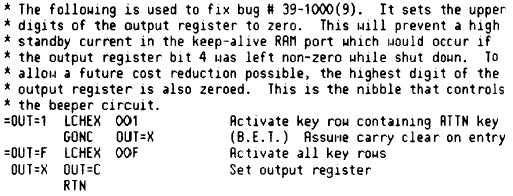
The ROM
1AAAA used code sequences such as:
LCHEX 1
OUT=CS
or
LCHEX F
OUT=CS
to drive the OR0 to 0R3 lines at power down or power up.
The OR4 output line is connected to port 5. So it is not recommended to use a
RAM module in card reader port (HHP 32K to 160K module for instance) with the
1AAAA ROM version.
Some 1AAAA bug fixes mentioned in the 1BBBB IDS:
957-1
issue with array parameter parsing (TI&FX1 ROM 1 Fix Module)
959-7 fix in CALC mode (AB&CLC Calc Mode p21,23)
960-5 unclear, related to functions (AB&FCN Functions p13, TI&FX2 ROM 2
Fix Module)
961-3 scratch registers rearranged with respect to TI%RM5 (AB&FCN Functions
p15)
997-7,
998-5, 999-3 RUN/CONT/CHAIN fixes (JP&SYS System Commands, RUN Loop p5)
1000-9 high standby current in RAM port after shutdown, see above (SB&DRV
Main Driver p27,37)
1017-3 related to quotes in expression decompile operations (SB&EXD
Expression Decompile p4,27, ROM 1 Fix Module)
1025-6 TRANSFORM copy from TAPE to RAM (FH&TFM Transform Execution p11)
1040-5 SST a return with ELSE following the GOSUB (SG&EXC Misc. Exec.
Routine p47,43, ROM 2 Fix Module)
(no ref) change in address protection for PEEK/POKE (SG&POK POKE Statement
Exec. p13, ROM 4 Fix Module)
(no ref) CALL/SUB with duplicate variables of different type (SC&SUB
SUBprog. and DEF FN p22, ROM 4 Fix Module)
(no ref) random access PRINT# bugs (SC&DAT Store & Retrieve data - PRINT# p3,43,60)
HP-71B 1AAAA Owner's Documentation Addendum
This addendum for the HP-71B version 1AAAA describes several bugs and workarounds (known HP bug numbers added):
Using Random Access to Store a String in a DATA File (no ref - see above)
Calling a Subroutine That Creates a File in RAM (1103-1°)
Single-Stepping through ...GOSUB ELSE... (1040-5)
Using DATE$ In an Expression (1078-5°)
Changing the OPTION BASE Setting Within a User Defined Function (985-2°)
Attempting transformation of Tape File (situation 2: 1025-6)
Chaining a File from Tape
Copying a Program from a Magnetic Card
Copying a TEXT File from a Magnetic Card
Using CHAIN :CARD in a Program
Using PROTECT and UNPROTECT in a Program
Using a Complex Subscript for an Array
Using READ# to Read Data into a Complex Variable (1082-7°)
Using an Expression Like (1,2,3,4,5,6,7,8) in CALC Mode (1095-9°)
° also present in version 1BBBB, see below
And of course, version 1AAAA has all the other bugs of version 1BBBB !
HP-71B ROM 1BBBB bugs
Note: "UDF" means "User Defined Function".
A more detailed description of the HP-71B 1BBBB bugs can be found in this HP document, dated Feb. 6, 1985.
More
bugs:
(source: internal HP
documents, Feb. 2, 1986)
1179-1
When current file is BINary, UDF in CALC mode cold starts.
1180-9 MERGE at low memory can cause a cold start: with ON ERROR in effect, or
with current file in IRAM.
1181-7 MERGE of a line with GOTO or GOSUB can cause cold start. MERGE must be
followed by RENUMBER.
1182-5 Doing MERGE & PURGE within a GOSUB can generate an "ERR:System
Error".
1183-3 CHAIN can cause infinite BASIC loop.
1184-1 PACK on an HP9114 disc drive can corrupt any or all files on disc.
1185-8 PRINT#, with string item, to external file can lose remaining data.
1186-6 Funny function which creates variables in a UDF corrupts variable chain.
See description below.
HP-71B ROM 2CCCC bug
Actually,
the bug was corrected in version 2CDCC.
The fix only involves the swap of a few nibbles in the 2nd ROM (hence the D in
2CDCC):
Address ROM 2CCCC: ROM 2CDCC: 0B4A1 167 D0=D0+ 8 167 D0=D0+ 80B4A4 14A A=DAT0 B 14A A=DAT0 B0B4A7 98201 ?C>A P / GOYES #0B4BA 16A D0=D0+ 11 ||0B4AC 118 C=R0 982D0 ?C>A P / GOYES #0B4BA ||0B4AF 16A D0=D0+ 11 118 C=R0 ||0B4B2 142 A=DAT0 A 142 A=DAT0 A0B4B5 CA A=A+C A CA A=A+C A0B4B7 140 DAT0=A A 140 DAT0=A A0B4BA 30A LCHEX #A 30A LCHEX #A0B4BD A6F D=D-1 B A6F D=D-1 B0B4C0 50E GONC #0B4A1 50E GONC #0B4A1
Below is the original 1AAAA/1BBBB version. This is the end of the CR-ARR (Create Space for an Array) routine:
Address ROM 1AAAA, 1BBBB: 0B4AD 16F D0=D0+ 160B4B0 162 D0=D0+ 30B4B3 14A A=DAT0 B0B4B6 98231 ?C>A P / GOYES #0B4CC0B4BB 118 C=R00B4BE 16A D0=D0+ 110B4C1 142 A=DAT0 A0B4C4 CA A=A+C A0B4C6 140 DAT0=A A0B4C9 18A D0=D0- 110B4CC 30A LCHEX #A0B4CF A6F D=D-1 B0B4D2 5AD GONC #0B4AD
The 2CCCC version saves 6 nibbles. I guess that due to the numerous bug fixes needed between 1BBBB and 2CCCC versions, it was necessary to optimize and pack all routines as much as possible. Unfortunately, the 2CCCC version doesn't do exactly the same thing than the 1AAAA/1BBBB version. But the HP engineers succeeded to fix it in 2CDCC version without adding a single nibble!
HP-71B ROM 2CDCC bug
Many known bugs of version 1BBBB were corrected in version 2CCCC/2CDCC. I can't give more details at the moment, I need to find the IDS document for version 2CCCC, I know it existed (see here). If you have it (original or copy), please contact me!
However, I was able to
check the status of some of the last bugs:
1179-1
fixed in 2CDCC
1180-9 not able to reproduce it with 1BBBB or 2CDCC ROM
1181-7 fixed in 2CDCC
1182-5 fixed in 2CDCC
1183-3 fixed in 2CDCC
1184-1 not a bug in the HP-71B, but rather a bug in the first release of the
9114 ROM. Don't use PACK with 9114!
1185-8 fixed in 2CDCC
1186-6 still not fixed in 2CDCC !
The last bug is still present in ROM 2CDCC. Below is a description of this bug, from an internal HP bug report document:
1186-6: Funny function which creates variables in a UDF corrupts variable chain.
Description: Creation of variable during funny function execution can corrupt memory. Example using FNROOT in MATH pac: 10 DESTROY ALL 20 DIM F(9), A$(9) 30 J=6 @ V=0 @ DISP J;V ! Compare the value of V ... 40 F(6)=FNROOT(10,12,FNY) 50 DISP J;V @ STOP ! ... with this value. 60 DEF FNY @ BEEP 500,.2 ! Just to count the FNY calls. 70 V=V+1 @ F(6)=FVAR @ Z6=1/V-.9 ! Stuff to make FNROOT work. 80 DIM Z$[34] ! This is the killer! 90 FNY=Z6 @ END DEFRunning the program will call FNY about 12 time; you can count thebeeps. Line 40 displays: 6 0but line 50 displays: 6 0.00001001 Replace DIM Z$[34] with DIM Z$[38], and line 50 shows: 6 1.Replace DIM Z$[34] with DIM Z$[78], and line 50 shows: 6 14 Creating a variable within a UDF called by a funny function causes theaddress of the pending assignment (F(6) in the example above) tobecome invalid. The assignment is made, and, in this case, it happensto be where V resides. Which variables get corrupted, or where, dependson the length of the new variable -- that's why the length of Z$ affectsthe new "value" of V. Workaround: Dimension all the variables before you execute a funny function which calls a UDF. For example, instead of creating the variables Z6 and Z$ within the UDF, create it on line 20: 20 DIM F(9), A$(9), Z6, Z$[34] Now the program will run correctly, with no corruption of variables.
HP-71B Y^X Accuracy Weakness (new Dec. 2025)
The HP-71B has a weakness regarding the accuracy of the y^x exponentiation operation when the result is very large or very small.
This weakness is not referenced here as a bug since there is no accuracy specification for this operation, however it seems worth to mention it here since the error can be much larger than normally expected by HP calculator users for similar operations.
Actually, all HP-71B successors based on the Saturn math code are affected by this weakness, this includes the RPL machines (Series 28, 48, 49, 50) and the simpler algebraic and RPN machines such as the HP-32S or HP42S.
One of the known worst case is the result of the 3^1006 operation:
HP-71B result: 9.63789627384e479
correct 12-digit result: 9.63789627402e479
for an error of 18 ULP (Unit in the Last Place)
Another particularly demonstrative case is
1E44^10.5 giving 9.99999999991e461 instead of 1e462 (a 9 ULP error).
By comparison, the y^x operation on the Capricorn family (that includes the HP-75C, the immediate predecessor of the HP-71B, with similar number accuracy and range) has an error no larger than 2 ULP over the full range, as described in a HP article (HP Journal, July 1980, p.28) and confirmed by the experience.
Clearly, the Saturn family was, for the y^x operation, a step behind.
See this forum article for a detailed accuracy benchmark and analysis.
The y^x accuracy was improved in a custom HP-71B ROM version 2DECC in 2025. The maximum error is expected to be limited to about 6 ULP, still not at the level of the Capricorn family, but significantly improved.
HP-71B User Manual Addendum
This french addendum for ROM 1BBBB describes the bug referenced as 1110-6 above, and the relevant workarounds:
- Do not use ON...GOTO/GOSUB when OPTION ROUND POS or OPTION ROUND NEG is in effect,
- The pointer expression used in an ON...GOTO/GOSUB statement (ON pointer expression GOTO/GOSUB) must not include any operators other than +, -, *, / or DIV, nor any functions (including user-defined functions, trigonometric functions, SQRT, etc.):
Incorrect:
ON FNJ(T) ^ SIN(M) GOSUB 500, 600, 700
Correct:
A = FNJ(T) ^ SIN(M)
ON A GOSUB 500, 600, 700
HP-71B Hardware Internal Design Specification
This document provides the full content of the chapter 8 (System Diagrams) that is not provided elsewhere.
HP-71 Hardware IDS Chapter 8, System Diagrams (PDF File, 0.9 MB).
HP-IL module
HP-IL ROM version 1A bugs:
The list below is based on a french addendum and describes the main bugs found in the HP-IL ROM version 1A.
1 - ENTER: if an under or overflow condition may occur during the entry of numeric data, either enter numeric data into a string variable and then use the VAL function to generate the numeric value, or else don't suppress warning messages (don't set flag -1) and don't put other variables after a numeric variable in an enter list.
For example, you can replace: ENTER 2;A,Bwith either of the techniques below: ENTER 2;A$,B$ A=VAL(A$) @ B=VAL(B$)or F=FLAG(-1,0) ENTER 2;A ENTER 2;B F=FLAG(-1,F)
2 - OUTPUT and PRINTER IS: avoid the remote
possibility of a Memory Lost condition during OUTPUT and PRINT operations by
taking either of the following precautions:
* use ENDLINE to set the end-of-line sequence to be either zero or three
characters long,
* or use OUTPUT and PRINT statements that don't send end-of-line sequences
(such as ending the statements with ';' and also setting an infinite
print-width for PRINT.
3 - CAT and CAT$: avoid certain conditions that can
cause a Memory Lost condition during a catalog operation by taking either of
these precautions:
* don't press any keys while the mass storage device is busy (while its BUSY
light is on),
* or be sure that the first file on the medium isn't purged (such as by packing
the medium whenever you purge the first file).
4 - PACK and PACKDIR: avoid the possibility of a Memory Lost condition while packing a medium by NOT using a user-defined function in the device specifier.
Bugs 2 and 3 were the
most serious ones. I remember that in these old good days I was always using a
3-character end-of-line sequence: ENDLINE CHR$(13)&CHR$(13)&CHR$(10)
(bug 2). It was also a good practice to create a dummy first file just after
disc initialisation to protect against bug 3.
See also below why PACK and PACKDIR should be avoided with the HP9114 (i.e.
they are not safe workarounds for bug 3).
I compiled a more complete list of ROM 1A bugs from an analysis of the HPIL 1B IDS.
HP-IL ROM version 1A limitations with the dual HP-IL adapter:
This HP82402A owner's
manual addendum provides updated
information on the use of the dual HP-IL adapter and limitations with the HP-IL
ROM version 1A.
In case of using both a module 1A and a module 1B in the dual HP-IL adapter, HP
recommends to put the module 1B in the first position (lower position) for the
newest version to take precedence. However, if the JPC ROM is present too, the
module 1B must be in the high position to correctly take precedence. This can
be checked by using the VER$ command: HPIL:1B must appear before HPIL:1A.
HP-IL ROM version 1A bugs with mass storage initialization (hidden by HP9114 firmware):
The HP-IL ROM version 1A
has two major bugs related to mass storage initialization. These two bugs occur
with drives supporting the "extended Filbert protocol", introduced
with the HP9114. The extended Filbert protocol adds commands to let the
controller know the physical size and geometry of the medium.
The two bugs are:
- the directory length is incorrectly set when using no explicit directory size
in INITIALIZE,
- the drive geometry is not correctly read, and the values written on the
medium by INITALIZE are wrong.
The bugs are documented and fixed in the HP-IL IDS (version 1B), module CAS page 7 and page
11 respectively.
The interesting thing about these bugs is that there are completely hidden by
the HP9114. The drive implements a validity check and replace abnormal values
with correct values, see the description of the format command in the HP9114 firwmare document page 30.
This is why these bugs have not been reported before and were not known by
users. However, the bugs can show up when using mass storage emulations (such
as ILPer) with a HP-IL ROM version 1A.
The bugs have been identified by Sylvain Côté during tests of
ILPer on 2014 and investigated by myself, Christoph Giesselink and Sylvain.
They have been briefly reported on the MoHPC forum on 2015.
HP-IL ROM PACK bugs:
The PACK command in the HP-IL ROM (both A and B versions) must be avoided if files may be added later by a HP-41. This problem is known since a long time, for instance see here a discussion of the problem.
Another problem with PACK is documented as bug 1184-1 in
this document. Here is a transcription of
the description (hard to read on the original document):
Description:
PACK on an HP9114 disc drive can corrupt any or all files on the disc.
The problem:
This is not a bug in the HP-71, but rather a bug in the first release of the
9114 ROM. It has been fixed in current release drives.
The bug is that the 9114 does not properly emulate the HP82161 correctly for
the "CLOSE RECORD" DLL command. If the last mode was not "write
to buffer" the disc does NOT write the data to the medium when the close
record is received, while the HP82161 does. The HP-71 (and the 75!) depend on
close record always writing the data to the medium to pack it, so this bug
causes destruction of data.
The effect of this bug is that the PACKDIR command on the HP-71 becomes a time-
? ? . PACK calls PACKDIR initially, then assumes that there are no PURGED
files left in the directory. As this assumption is not correct in the (buggy
version of the) 9114, data is lost as files may be moved *farther out* on the
medium.
HP-IL ROM end-of-directory bug:
This bug is mentioned by J.K. Horn in the Titan File #16
(HPX Exchange, V2 N1, Jan 1989, page 15; or Titan File
Collection):
"The HP-71's HPIL module (both A and B versions) has a bug that allows a
disk catalog to contain one too many entries. If this occurs, the first record
of the contents of the first file on the disk gets erased."
Actually, the bug is that the end-of-directory mark
overrides the first 32 bytes of the first file, when the directory gets full.
It is pretty easy to reproduce the bug by doing INITIALIZE ":TAPE",8
then copying 8 files on :TAPE. The first file is then corrupt.
I found the cause of the bug in the NEWFIL
function in the HPIL IDS, module CAS.
Workaround: create a dummy first file (e.g. CREATE DATA
DUMMY:TAPE,1) after INITIALIZE.
It is even better to set the name of the dummy file in lower case, so it can't
be accessed or purged. There are many ways to do it, but an easy one with the
JPC ROM (after INITIALIZE and CREATE dummy file) is:
DIM A$[256] @ A$=RREC$(2,":TAPE") @
A$[1,10]="dummy " @ WREC
A$,2,":TAPE"
HP-IL user manual (edition 3, January 1985) incorrect information:
The 3rd
and last edition of the HP-IL manual dated January 1985, incorrectly mentions
on page 241 two error messages (255021 "Low
Battery" and 255029 "Medium Protect") that are not mentioned in
previous editions of the HP-IL manual. These error messages are actually not
present in the HP-IL modules version A or B.
The reason of the addition of these non-existing messages in the edition 3 is
unknown.
Note also
that all user manual editions incorrectly mention the error message 255027
"End of File" (page 238 of the 3rd
edition) that is not present in the HP-IL modules version A or B.
Another mistake in the HP-IL user manual (all editions) is that the type of a secured text file is not -7979 (0xE0D5) but
-7983 (0xE0D1) as defined in the source code (HP71 IDS, module TAB page 4). This mistake is also found in other
documents, for instance in the Forth/assembler ROM manual.
HP-IL Internal Design Specification Update
This is the IDS release, HP Part No. 82401-90023, dated March 1984.
Note that the actual HP-IL ROM 1B, dated August 1984, exhibits some code differences in the Display Driver module, the changes are hand-written on the updated pages of the volume 2.
HP-IL IDS Vol.1 March 1984 (PDF File, 66 MB).
HP-IL IDS Vol.2 March 1984 includes the March 1984 updated pages (PDF File, 42 MB).
HP-IL IDS Vol.2 update updated pages for the IDS Vol.2 preliminary version dated January 1984.
HP-IL ROM source files version 1B build
<840807>
Math Module 1A
Although no real bug are known, some unexpected behaviours have been noted:
· FNROOT
One case of FNROOT failure (actually FNROOT doesn't terminate in a sensible delay) was reported by V.Albillo (Datafile V24N1, 2005):
FNROOT(0, 0, FVAR * FVAR + 1)
FNROOT still didn't terminate after more than 30 minutes with Emu71@1.7GHz, equivalent to about 10 days with real HP-71B.
R. Rosenbaum noticed that FNROOT does terminate in this case if OPTION ROUND POS is used.
· INV
Instead of MAT B=INV(A), it is better to do MAT B=SYS(A,I) where I is an identity matrix of same size than A and B.
e.g. inverting the matrix [[1 2][3 4]]:
MAT B=INV(A) gives: B= [[-1.99999999998, .999999999994][1.49999999999, -.499999999997]]but MAT B=SYS(A,I) gives: B = [-2 1][1.5 -.5]] · DET function
DET may produce a non-integer answer for an integer matrix:
e.g. with A = [[1 2][3 4]] DET(A) gives -2.00000000001 instead of -2.
DET may produce weird outputs for a non-invertible matrix:
e.g. A = [[0 1][0 0]] DET(A) gives the correct answer (0), but with the message "Warning: Overflow"A = [[0 0][1 0]] DET(A) gives -0. · internal summation weakness
The Math ROM 1A also has a weakness related to the internal 15-digit summation operation used in matrix operations.
The issue is that the Math ROM is using a 15-digit truncating addition instead of rounding each addition result.
For example, computing DOT([-10000 (1/3) 10000],[1 1 1]):
this operation computes (-10000)+(1/3)+(10000) with 15 digits and should return .33333333333but the Math ROM 1A is returning .33333333334 .
This weakness is causing the HP-71B Math ROM 1A to deliver answers that may be slightly different from later Saturn-based machines (starting with the HP-28C) for several matrix operations using summations such as dot product, matrix product and inversion, determinant and system solving.
For example, computing the determinant of the matrix [[69 58 96][51 43 71][32 55 54]]:
this operation returns 1.00000038313 on the 71B,the 28S and 42S return 1.00000038333 instead.
This is not considered as a bug since the answer is not "wrong" (and not worse than the 28S/42S), just the Math ROM 1A is not always consistent with later machines.
For more information on the Math ROM, please have a look at my Math ROM page.
FORTH/Assembler Module 1A Bugs
The assembler in the FORTH/Assembler module has the following bugs:
- the B=B+B A opcode has a bad class. B=B+B A must be replaced by NIBHEX C5 in source files,
- the D1=AS opcode is incorrectly assembled as 138, which is actually D0=AS. D1=AS must be replaced by NIBHEX 139 in source files,
- ASSEMBLE must be launched in DECIMAL mode to correctly build LEX with more than 10 keywords,
- during the assembly of FORTH primitives, a warning 'word not unique' message can appear when it shouldn't,
- when the symbol table has more entries than will fit on one page, the second page reports invalid values for the entries.
A fix of
the first two bugs can be easily done by patching the ROM code: FORTH assembler fix (note that patching
"ROM" code is only possible in emulators or using a FRAM71 module).
Here is a simple test to check these two
bugs and the fix.
The remaining bugs are minor. The third bug has a simple workaround (as
mentioned above) and the last two bugs are described in the chapter 12 of the FORTH IDS.
Note also that the D0=HEX and D1=HEX undocumented (but accepted) opcodes don't work correctly.
Another small bug is that the FORTH Assembler generates null-bytes at the end of some lines in the assembly listing. This can be noticed when using Emu71 or ILPer, see here for a discussion.
The actual assembler message #36 (i.e. MSG$(47036)) in the ROM is "too many ascii chars present", not in accordance with the owner's manual and the FORTH LEX source file that both describe the message as "too many ASCII chars present" (ASCII in upper case).
For an updated version usable in emulators, see my page with the FORTH/Assembler revision B.
JPC ROM Versions and Bugs
A list of JPC ROM features and bug fixes for versions A to F, is described in this JPC ROM version history.
An unofficial JPC ROM fix
was made by Rodger Rosenbaum as version 'X' circa 1992, based on the version
'D'. It is described in this note from J.K. Horn.
A remaining known bug in version X was related to date functions dealing with leap
years: e.g. DOW$("02.291999") incorrectly returns "Monday"
instead of an error.
A serious bug was introduced in version X: the RED$ and CENTER$ functions crash
the HP71 if the argument is a null ("") or space-only
(" ") string.
The last version 'F' (2007) merges the fixes and improvements of versions X and E together, plus a few extra changes. Revisions up to F04 have the RED$/CENTER$ bug mentioned above, that has been fixed in revision F05.
For more details on the JPC ROM, please have a look at my JPC ROM page.
Contact
If you have more
information on HP-71B system versions or bugs, please contact me : ![]()
J-F Garnier, 2025
